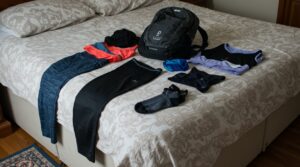What to wear
Refugees don’t get to wear fancy hiking gear when they’re forced to leave in a hurry, so neither do you. In honour of those who don’t have the luxury of specialised clothing, all participants are asked to wear modest Islamic dress layered over appropriate activewear.
1. Base layer
- Running leggings: Choose leggings designed for athletic activities, providing comfort and flexibility.
- Quality sports bra: Ensure proper support to handle intense movement.
- Gloves (optional): Consider wearing gloves to protect your hands from mud and rough surfaces.
2. Inner layer
- Trousers: Wear moisture-wicking trousers to keep warm and dry.
- Long-sleeve top: Opt for a fitted, breathable top as an additional barrier.
- Tight-fitting underscarf: This will keep your hair secure under your outer hijab.
3. Outerwear
- Modest Islamic dress: Wear a full-length abaya or a loose, modest suit. Sisters are encouraged to wear an abaya they hold dear, as a reminder of the emotional connection to what refugees must often leave behind.
- Hijab or khimar: Cover your hair with a traditional hijab or khimar, adjusted securely.
- Niqab: If you wear niqab daily, wear it during the challenge.
4. Footwear
- Trainers or shoes: Use tightly laced trainers or footwear that can handle muddy terrain. Avoid metal spikes or studs.
- Synthetic running socks: These dry quickly and help prevent blisters.

What to bring
Being well-prepared will ensure your comfort and help you transition smoothly after the challenge.
- Large towel: Essential for drying off after completing the course.
- Complete change of clothes: Pack dry, warm clothing to change into for your journey home.
- Two bin bags: Use one for your muddy clothes and the other for dirty shoes.
Suggested packing list
- Rucksack: Line it with a bin bag to keep your belongings dry, and place your change of clothes and towel inside.
- Full change of clothes: Make sure you have everything from clean socks to a warm top.
- Sturdy, waterproof footwear: For wearing post-challenge, as well as a lightweight change of shoes.
- Prayer mat & bottle of water: Useful for making wudu and praying comfortably after the challenge.
- Waterproof pouch: Keep any valuables like a phone, wallet or keys in a sealable, waterproof pouch to protect them from mud and water.
Good luck!
Embrace the trials with courage and an open heart, and take the opportunity to reflect deeply on the struggles faced by those who undertake journeys of survival in dire conditions.